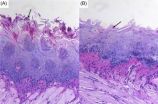(Press-News.org) VIDEO:
As the conductor drives, the device captures one the seven universal emotions: fear, anger, joy, sadness, disgust, surprise, or suspicion.
Click here for more information.
Technology now allows us to read facial expressions and identify which of the seven universal emotions a person is feeling: fear, anger, joy, sadness, disgust, surprise, or suspicion. This is very useful in video game development, medicine, marketing, and, perhaps less obviously, in driver safety. We know that in addition to fatigue, the emotional state of the driver is a risk factor.
Irritation, in particular, can make drivers more aggressive and less attentive. EPFL researchers, in collaboration with PSA Peugeot Citroën, have developed an on-board emotion detector based on the analysis of facial expressions. Tests carried out using a prototype indicate that the idea could have promising applications.
It's not easy to measure emotions within the confines of a car, especially non-invasively. The solution explored by scientists in EPFL's Signal Processing 5 Laboratory (LTS5), who specialize in facial detection, monitoring and analysis, is to get drivers' faces to do the job. In collaboration with PSA Peugeot Citroën, LTS5 adapted a facial detection device for use in a car, using an infrared camera placed behind the steering wheel.
The problem was to get the device to recognize irritation on the face of a driver. Everyone expresses this state somewhat differently – a kick, an epithet, a nervous tic or an impassive face. To simplify the task at this stage of the project, Hua Gao and Anil Yüce, who spearheaded the research, chose to track only two expressions: anger and disgust, whose manifestations are similar to those of anger.
Two phases of tests were carried out. First, the system "learned" to identify the two emotions using a series of photos of subjects expressing them. Then the same exercise was carried out using videos. The images were taken both in an office setting as well as in real life situations, in a car that was made available for the project.
The rapidity with which the comparison between filmed images and thus detection could be carried out depended on the analysis methods used. But overall, the system worked well and irritation could be accurately detected in the majority of cases. When the test failed, it was usually because this state is very variable from individual to individual. This is where the difficulty will always lie, given the diversity of how we express anger. Additional research aims to explore updating the system in real-time – to complement the static database – a self-taught human-machine interface, or a more advanced facial monitoring algorithm, says Hua Gao.
Detecting emotions is only one indicator for improving driver safety and comfort. In this project, it was coupled with a fatigue detector that measures the percentage of eyelid closure. The LTS5 is also working on detecting other states on drivers' faces such as distraction, and on lip reading for use in vocal recognition. These projects are coordinated by EPFL's Transportation Center and carried out in collaboration with PSA Peugeot Citroën.
INFORMATION:
Emotion detectors could make driving safer
EPFL scientists are studying how to identify drivers' emotions using embedded cameras that film their faces
2014-03-14
ELSE PRESS RELEASES FROM THIS DATE:
Pancreatic cancer surgery findings presented at SSO
2014-03-14
CLEVELAND – Despite the benefits of surgery for early stage pancreatic cancer, it remains under-utilized for patients with this deadly disease, according to a new national analysis of trends and outcomes. Physician-scientists at University Hospitals Case Medical Center and Case Western Reserve University School of Medicine presented their findings and strategies to increase rates at the Society of Surgical Oncology Cancer Symposium in Phoenix.
In an abstract titled "Factors Associated with Failure to Operate for Localized Pancreatic Adenocarcinoma," the research team ...
Mindfulness-based meditation helps teenagers with cancer
2014-03-14
This news release is available in French. Mindfulness-based meditation could lessen some symptoms associated with cancer in teens, according to the results of a clinical trial intervention led by researchers at the University of Montreal and its affiliated CHU Sainte-Justine children's hospital. Mindfulness-based meditation focuses on the present moment and the connection between the mind and body. Adolescents living with cancer face not only the physical symptoms of their condition, but also the anxiety and uncertainty related to the progression of the disease, the ...
Education and culture affect children's understanding of the human body
2014-03-14
The study found that children as young as four and five can understand that the human body works to keep us alive. The researchers call this a 'life theory' and say it is important because it enables children to understand other related biological facts, such as what the vital organs do to keep us alive and what happens when people die. The results also have implications for teaching about the human body in schools.
The research, published in the British Journal of Developmental Psychology, aimed to identify the age by which children begin to demonstrate a biological ...
Higher exposure to takeaway food outlets could double the odds of being obese
2014-03-14
People exposed to takeaway food outlets around their home, at work and on their way to work are more likely to consume more of these foods, as well as being more likely to be obese, suggest a paper published on bmj.com today.
During the past decade in the UK, consumption of food away from home has risen by 29% while the number of takeaways has increased dramatically. This, the researchers say, could be contributing to rising levels of overweight and obesity.
Despite increasing policy focus, identifying the association between exposures to unhealthy neighbourhood food ...
Cancer patients with insulin-treated diabetes have 4 times higher mortality compared to cancer patients without diabetes
2014-03-14
People who have diabetes at the time they are diagnosed with cancer are more likely to die early than those without diabetes, concludes research published in Diabetologia (the journal of the European Association for the Study of Diabetes). The research is by Kristina Ranc, University of Copenhagen and Steno Diabetes Center, Gentofte, Denmark, and colleagues. The researchers conclude that patients with both diabetes and cancer constitute a particularly vulnerable group, and efforts are needed to reduce cancer-related mortality among these patients.
While the research base ...
Fighting for oral dominance: Good fungi keep bad ones in check in healthy mouths
2014-03-13
Human mouths contain a balanced mix of microbes which, when disrupted, can lead to oral diseases. A study published on March 13th in PLOS Pathogens compares the bacteria and fungi present in the mouths of healthy individuals with those from patients infected with HIV, and illustrates why oral candidiasis (aka "thrush") is a common complication of HIV infection.
Using high-throughput gene sequencing, Mahmoud Ghannoum, from Case Western Reserve University in Cleveland, USA, and colleagues catalogued the core oral bacteriome (the bacteria commonly present) and the core ...
Autism and intellectual disability incidence linked with environmental factors
2014-03-13
An analysis of 100 million US medical records reveals that autism and intellectual disability (ID) rates are correlated at the county level with incidence of genital malformations in newborn males, an indicator of possible congenital exposure to harmful environmental factors such as pesticides.
Autism rates—after adjustment for gender, ethnic, socioeconomic and geopolitical factors—jump by 283 percent for every one percent increase in frequency of malformations in a county. Intellectual disability rates increase 94 percent. Slight increases in autism and ID rates are ...
Microorganism shows promise in inhibiting thrush
2014-03-13
Scientists at Case Western Reserve School of Medicine and University Hospitals (UH) Case Medical Center have discovered how the beneficial fungal yeast, Pichia, holds at bay a harmful fungal yeast, Candida. The hope for this finding is that components in Pichia could one day become therapeutic agents to stave off not only thrush, but also other life-threatening systemic fungal infections. Research findings about the effect of oral Pichia on Candida appear in the March 13 edition of PLOS Pathogens.
"Our aim was to try to understand what microorganisms live in our mouths. ...
Negative effects of joining a gang last long after gang membership ends
2014-03-13
Imagine two children, both with the exact same risk factors for joining a gang. As teenagers, one joins a gang, the other doesn't. Even though the first teen eventually leaves the gang, years later he or she is not only at significantly higher risk of being incarcerated and receiving illegal income, but is also less likely to have finished high school and more likely to be in poor health, receiving government assistance or struggling with drug abuse.
University of Washington researchers have found that joining a gang in adolescence has significant consequences in adulthood ...
Stroke survivors may lose month of healthy life for 15-minute delay in treatment
2014-03-13
Every 15-minute delay in delivering a clot-busting drug after stroke robs survivors of about a month of disability-free life, according to a new study in the American Heart Association journal Stroke.
On the other hand, speeding treatment by just one minute means another 1.8 days of healthy life, researchers said.
"'Save a minute; save a day' is the message from our study, which examined how even small reductions in treatment delays might benefit patients measurably in the long run," said Atte Meretoja, M.D., Ph.D., M.Sc., lead author of the study and associate professor ...
LAST 30 PRESS RELEASES:
Researchers identify gene that calms the mind and improves attention in mice
Artificial metabolism turns waste CO2 into useful chemicals
Ancient sea anemone sheds light on animal cell type evolution
Begging gene leads to drone food
How climate policies that incentivize and penalize can drive the clean energy transition
Can community awareness campaigns in low-resource areas improve early diagnosis of colorectal cancer?
Stardust study resets how life’s atoms spread through space
Practical education: Clinical scenario-based program development
The impact of family dynamics on eating behaviour – how going home for Christmas can change how you eat
Tracing the quick synthesis of an industrially important catalyst
New software sheds light on cancer’s hidden genetic networks
UT Health San Antonio awarded $3 million in CPRIT grants to bolster cancer research and prevention efforts in South Texas
Third symposium spotlights global challenge of new contaminants in China’s fight against pollution
From straw to soil harmony: International team reveals how biochar supercharges carbon-smart farming
Myeloma: How AI is redrawing the map of cancer care
Manhattan E. Charurat, Ph.D., MHS invested as the Homer and Martha Gudelsky Distinguished Professor in Medicine at the University of Maryland School of Medicine
Insilico Medicine’s Pharma.AI Q4 Winter Launch Recap: Revolutionizing drug discovery with cutting-edge AI innovations, accelerating the path to pharmaceutical superintelligence
Nanoplastics have diet-dependent impacts on digestive system health
Brain neuron death occurs throughout life and increases with age, a natural human protein drug may halt neuron death in Alzheimer’s disease
SPIE and CLP announce the recipients of the 2025 Advanced Photonics Young Innovator Award
Lessons from the Caldor Fire’s Christmas Valley ‘Miracle’
Ant societies rose by trading individual protection for collective power
Research reveals how ancient viral DNA shapes early embryonic development
A molecular gatekeeper that controls protein synthesis
New ‘cloaking device’ concept to shield sensitive tech from magnetic fields
Researchers show impact of mountain building and climate change on alpine biodiversity
Study models the transition from Neanderthals to modern humans in Europe
University of Phoenix College of Doctoral Studies releases white paper on AI-driven skilling to reduce burnout and restore worker autonomy
AIs fail at the game of visual “telephone”
The levers for a sustainable food system
[Press-News.org] Emotion detectors could make driving saferEPFL scientists are studying how to identify drivers' emotions using embedded cameras that film their faces



